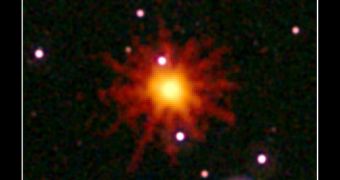While analyzing the skies in the direction of the constellation Draco, the Swift Gamma Burst Mission spacecraft discovered a massive gamma-ray flash taking place on March 28. Experts now say that the event was most likely caused by a massive star falling into a black hole.
Since the emission was first detected, astronomers have been trying to determine what happened in the nearby constellation, that led to such vast amounts of high-energy light being released in the Universe.
The impressive gamma-ray burst (GRB) was found to originate in a collapsing star, in the same way other similar emissions were found to have the same source. The object was designated GRB 110328A.
Astronomers from the University of California in Berkeley (UCB) led the research team that finally established the nature of the event that spawned this massive outburst of energy. The researchers were surprised to see the GRB originating in a binary system.
Apparently, the star that met an unexpected end was part of the same system as a black hole, which literally consumed all of its matter. Eventually, the entire star was gobbled up by the dark behemoth.
“This is truly different from any explosive event we have seen before,” explains UCB expert Joshua Bloom, who first proposed that the source of GRB 110328A was a dying, Sun-sized star.
The black hole that destroyed the star is estimated to tip the scales at around one million solar masses. This was confirmed by observations conducted using the NASA Hubble Space Telescope and the Chandra X-ray Observatory.
Details of the new investigation appear in the June 16 online issue of the journal Science Express. “This burst produced a tremendous amount of energy over a fairly long period of time, and the event is still going on more than two and a half months later,” Bloom explains.
“That’s because as the black hole rips the star apart, the mass swirls around like water going down a drain, and this swirling process releases a lot of energy,” the UCB associate professor of astronomy adds.
“Here, you have a black hole sitting quiescently, not gobbling up matter, and all of a sudden something sets it off. This could happen in our own galaxy, where a black hole sits at the center living in quiescence, and occasionally burbles or hiccups as it swallows a little bit of gas,” he adds.
“From a distance, it would appear dormant, until a star randomly wanders too close and is shredded,” Bloom concludes.

 14 DAY TRIAL //
14 DAY TRIAL //